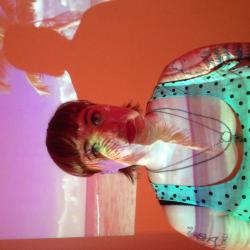Kárahnjúkar gets exploded via artistic licence
A white infant-sized coffin sits atop a mound of sullen black sand guarded by two cardboard heads holding an impasse ribbon in their mouths. As one steps into Nýlistasafnið (The Living Art Museum) and sees this grizzly scene, the eye is drawn up above the miniature casket to a wreath of white ribbons with garlands adorned with political clichés extending from either side.
This is the welcoming scene to the new exhibit by art duo Angeli Novi entitled ‘You Can’t Stand in the Way of Progress.’ The duo is comprised of artists and social activists Steinunn Gunnlaugsdóttir and Ólafur Páll Sigurðsson, the founder of Saving Iceland. Steinunn has also been closely involved with the organisation since its founding and both were present during the protests against the construction of the Kárahnjúkar dam starting in 2004. Their new exhibit addresses the irony of economic ideologies with regard to the consumption of natural resources, human tragedy and politically motivated destruction.
This is mainly conveyed through a 20-minute film where thirty people were voluntarily buried alive. Up to their necks in sand, both confined and vulnerable to the elements, they hold the same political-cliché-garlands from the entrance display in their mouths. Each shot displays them in pairs, and one trio, with a symbolic tug-of-war of ideology as they chew up or spit out the message caught between their teeth. Behind these living corpses flash toxic images of industry, war, death and exploitative scenarios as a mechanical droning soundscape by Örn Karlsson crackles, screeches and explodes.
The human actions convey a sense of struggle and imprisonment between nature, politics and belief, as well as raise questions about morality. Kárahnjúkar’s mechanics are featured prominently throughout, with one particularly climactic scene of an overhead shot of the dam, which is then promptly blown to smithereens by computer generation. Call it social activist catharsis.
However, the simple power of industrial dominance and political platitudes loses much of its weight as the filmmakers gratuitously throw in easy target shocker footage. For example, partly blurred but still very hardcore pornography, an open grave of guerrilla warfare casualties, a still of open caskets of dead Russians out of pogroms, and of course a shot of the first plane hitting the Twin Towers. Their flippant use of these images ends up feeling cheap, like lazy attempts to emotionally manipulate the viewer rather than produce meaningful content. As they try to increase the “power,” the real message gets convoluted.
As “The End” appears on screen, one notices another room off to the left, delineated by clear plastic meat-locker curtains. Ominous green lighting oozes out over a curious apparatus covered with questionable black fluff. Entering the room reveals a mass of torn seagull feathers and skin strewn across a torture-device of a conveyor belt. The smell suddenly hits with a dry, sallow stench that goes straight for the back of the palate. “Do you smell that?” I turn and ask my cohort, raising my scarf over my face. “Of course,” she replies, backing out of the room. “It smells like one-thousand dead birds.”
Buy subscriptions, t-shirts and more from our shop right here!
















